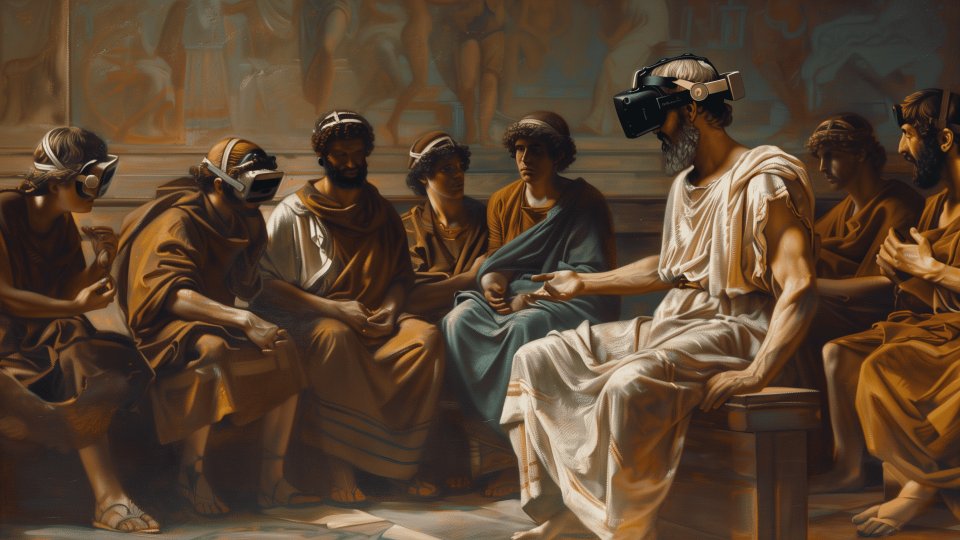Consider the AI classroom of a very-near future where a quiet revolution is underway, fundamentally altering the role of educators. Gone is the traditional "sage on the stage" model of teaching, replaced by a dynamic, blended approach that combines the efficacy of the Socratic method with the cutting-edge capabilities of artificial intelligence (AI).
The Socratic teaching method is a form of teaching that encourages critical thinking and insightful discussion through asking and answering questions. Instead of giving direct answers, the teacher poses thought-provoking questions to students, challenging them to explore the topic deeply and develop their own understanding.
They guide each student's learning journey, orchestrating personalised experiences that not only lessen their own workload but also significantly enhance educational outcomes. Ken Corish (SWGfL Online Safety Director) explores how it could impact on teaching and learning.
What Might this Look Like?
It’s difficult to predict AI’s path and how it may eventually shape our engagement with technology. Its development, capability and engagement accelerate with each passing week.
However, one thing is for certain. It is a path the world is on and to understand this technology to control it, particularly from a cultural perspective.
The learning ecosystem could shift to include:
AI-Driven Personalised Instruction: Each student interacts with AI-driven platforms for direct instruction, which adapts to their learning pace, preferences, and interests. AI could provide lessons, exercises, and assessments tailored to the individual learner's current level of understanding and knowledge gaps.
Teachers as Facilitators of Inquiry: Teachers shift from being the primary source of knowledge to facilitators of learning. They use Socratic questioning to provoke deep thinking, challenge assumptions, and encourage students to explore complex ideas and problems. This approach promotes active, rather than passive, learning.
Collaborative Learning Environments: The classroom becomes a hub of collaboration and discussion. After engaging with AI for initial learning phases, students come together to discuss concepts, share insights, and tackle problems with the teacher guiding the discourse, encouraging peer-to-peer learning and critical engagement with ideas. This lends itself to the concept of flipped-learning where research and knowledge-acquisition are owned by the student and the classroom then shapes and refines the learning in a dynamic way.
Focus on Higher-Order Thinking Skills: With AI contributing to foundational knowledge instruction, teachers can concentrate on developing students' higher-order thinking skills—such as analysis, synthesis, evaluation, and creation. These skills are nurtured through carefully crafted questions and challenges that encourage students to think deeply and critically.
Real-World Problem Solving: Teachers can use the insights gained from AI about students' progress and interests to design projects that address real-world problems. This approach connects learning to tangible outcomes and societal issues, enhancing relevance and motivation.
We’ve Been Here Before?
There is an argument that suggests that all technology adoption is cyclical and we have been on the cusp of the next big thing many times before. But this feels fundamentally different than just faster, cheaper and mobile.
There are some clear potential benefits:
Personalisation of Learning: AI's ability to tailor instruction to each student's needs could enhance engagement and mastery of subject matter, potentially accelerating learning outcomes.
Reducing Administrative Workload: Many of the day-to-day classroom tasks are time sinks. Marking; recording; assessing; planning and preparing appropriate content. Anything that reduces the burden of these allows space and capacity to reflect and guide.
Development of Critical Thinking Skills: The Socratic method, facilitated by teachers, nurtures critical thinking and reasoning skills, preparing students for complex problem-solving in real-world contexts.
Adaptive Learning Paths: AI can continuously assess student progress and adapt learning materials accordingly, ensuring that students are always challenged but not overwhelmed.
Engagement and Motivation: This model could lead to increased student engagement and motivation, as learning becomes more relevant to their interests and needs, and they actively own in their own learning process.
But like any new paradigm shift, there are challenges and investments to be considered.
Staff development: Effective implementation requires teachers to be well-trained in Socratic questioning techniques and comfortable integrating AI tools into their teaching practices.
Shaping student use of AI technologies: establishing knowledge and skills is equally important here as shaping cultural and ethical attitudes to AI-assisted learning. This doesn’t happen entirely through osmosis and will need to be built into the curriculum.
Access to Technology: Ensuring equitable access to the necessary technology for all students is crucial to prevent widening the digital divide. What that technology may eventually end up being is hard to determine right now but it probably won’t look like a mobile phone or tablet.
Quality of AI Content: The effectiveness of AI as a tool for direct instruction depends on the quality and appropriateness of the content it delivers, necessitating ongoing oversight and curation. It’s promising... but doesn’t feel like it is there yet.
Maintaining Emotional and Social Development: The teacher's role in supporting students' emotional and social development becomes even more critical, as AI cannot replicate the empathy, understanding, and rapport that human teachers provide.
Isn’t this all a bit too aspirational?
It’s worthwhile to project how we can improve the experience of learning alongside the enjoyment of teaching. We are all well-aware of the recruitment and retention crisis we have had in the profession over the last few years. Anything we can do to make teaching an attractive career prospect for the next generation of young educators is worth exploring.
Technology doesn’t make good teachers. But if it could assist with the heavy lifting of non-teaching tasks that many professionals find themselves mired in, then surely that gives the space for the emergence of great teachers with the time, space and capacity to do what they are best at.
You know... teach.
If you are keen to experiment with what a typical Socratic Flow might look like, then I have created an exclusive GPT for those with a ChatGPT Premium account.
You can find the SOCRATES GPT on this link
Alongside highlighting the possibilities of AI technology, SWGfL are also providing a balanced overview, exploring considerations and guidance to support the safe use of platforms such as ChatGPT within schools.
Discover more from the SWGfL AI Hub
| This content and the image used were structured and organised with the assistance of AI technology |






